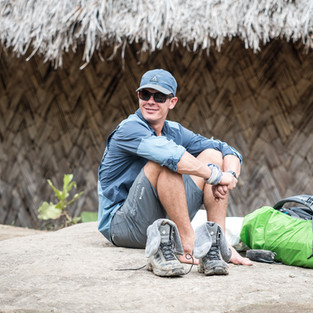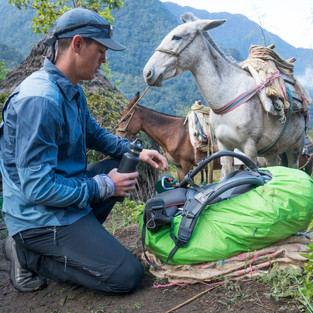a journey to sacred lands
- Mark Chase

- Mar 15, 2017
- 5 min read
Updated: Apr 25, 2018
We drove until the road turned into a trail. From there we had a 7 hour hike into the Sierra Nevada de Marta mountains of Colombia. Worst case scenario was that we’d be sent back in the dark. The best-case scenario was a further 4 days of 10 hour hikes high into the mountains.

It was our intention to reach a village occupied by the Indigenous Kogi people who have protected the area for hundreds of years. They were weary of outsiders after they were forced to flee into the mountains during the Spanish conquest. Despite having made contact before embarking on our expedition there was still a strong possibility that we would be turned back when we reached the village.
After an extremely difficult hike, we endured our first unearthly Colombian downpour about an hour outside of the Kogi Village. The downpour made the trails almost impassable and as it rained we could do nothing but stand and wait for it to ease before continuing. Eventually it let up, as it did every afternoon and we were able to continue on to the Kogi Village. The first and perhaps most important stop on our journey.

Here we met with one of the community’s ‘Mamos’. The Mamos are the leaders of the community and believed to be the most in touch with the land. Originally, the Mamos were selected at birth. They would spend the first years of their lives in dark caves and be taught about the surrounding land without ever seeing it.
We lined up in front of the Mamo as he perched on a rock in front of us. He then spoke in Kogi which was translated to Spanish and eventually to English. Individually we were each asked what our intentions were and what we hoped to achieve from being there. One by one we answered and the Mamo considered what we had said. We were all conscious that it was not beyond possibility that one or all of us may not be allowed to proceed if we were not deemed worthy or sincere by the Kogi.
After some long exchanges in Kogi, none of which were translated, we were asked to step forward. As we crouched the Mamo tied a small piece of cotton around our wrists and told us that it would protect us on our journey.

He warned us that when the rain came in the afternoon we must stop. He told us how he was worried that if we continued the village may be in danger. That we may anger the mountains. With this warning, we were allowed on our way.
After another long and humid hike through the jungle and cloud forest we arrived at our second proposed campground. It’s worth noting that there aren’t many places along the route that are wide enough to spend the night. Much of it is dense jungle and as soon as you breech the tree line you’re on a narrow winding ridge. We set up camp and settled in right before the rain, which came every afternoon. I remember that afternoon sitting in my tent alone eating my supper and contemplating what a surreal experience this was.
After a good rest, we knew that we would break the tree line, we gained another 2,000 feet to reach what would become our high camp at 12,000 feet above sea level. It is crazy when you consider that just three days prior, we had started this journey from the Caribbean beaches of the Santa Marta. This day had been designed to be shorter due to the technicality of the hike, and provide us with a break before our final day. We would hopefully reach the sacred lakes at around 14,000 feet up in the highest coastal mountain range in the world.

We spent 6 hours hiking in the beating sun with little natural protection from the elements. It was a significant departure from the type of landscape we’d previously been hiking. To our surprise, we didn’t experience anymore downpours on the way up to our high camp. Every day we watched the valley we had come from fill up with clouds, but at 12,000 feet we avoided the downpour, hence the change in landscape.
Our high camp consisted of two Kogi huts resting in an isolated clearing next to the river. It seemed a strange place for just two huts to be standing. It wasn’t like the village we had stayed in at the start of our journey. As we soon learned, only one small Kogi family lived in these huts.
They had been expecting us.
I have no idea how! It’s not like the lower village could send a text message to let them know. Regardless, we were welcomed with some sugar water and dried meat. I wish I could tell you what animal the meat was from but honestly, I don’t know. It had been dried in the sun for what must have been weeks. It was both the best and the strangest jerky you’ve ever tasted. We pitched our tents and sat around chatting.
It was clear that the altitude was starting to take a grip on a few members of the team. Headaches started to occur and everything just seemed much harder than it had 24 hours earlier. Despite the group feeling fatigued, we knew that we had one more push the following day to reach the lakes. We discussed and decided that we would attempt a true ‘alpine’ start at around 2:00am, pack light, and head up the mountain to the lakes at around 14,000 feet and then return to this camp before darkness. With the plan set, everyone went to get some rest.
We set off the next morning under moonlight bright enough to negate the use of headlamps. The ever-changing landscape had a few more surprises for us. We set off into a grassy field, then scrambled up rocks, before eventually reaching a desert. It felt like a dream when you considered that 24 hours prior we had left what was essentially a rainforest. As we continued, the terrain flattened and we reached the first of the hidden lakes. It was very surreal standing at the shores of these lakes with mountains towering around us knowing that we were already higher than I had ever been on foot. The other thing that I wasn’t expecting were beaches. Yep, beaches.
The lakes had their own pristine white sand beaches.

After pausing to take in the amazing scenery and a hot drink, we continued upwards. To get further into the mountains we had to cross another long stretch of barren, dry land before reaching drenched, mossy marshland and yet more hand-over-hand scrambling on the rocks.
This journey really had seen such dramatic changes in landscape and life. The final one and perhaps most spectacular of all. Snow!
As the rocks gave way to the crystal-clear lakes nestled at 14,000 feet your eyes were drawn one way and that was up. Towering a further 4,000 feet above the lakes were some of the highest peaks in Colombia. The snowcapped peaks watched over the lakes and it all became very clear why the Kogis saw this place as the center of the world. It was like nothing I had ever seen before
At the lake, we were led through a ceremony. One of the younger Kogi guides handed us each a small piece of cotton he had picked from a plant nearby. As we perched on the rock overlooking the lake, we held the cotton between thumb and forefinger, closed our eyes and were asked to think about everything we wanted to leave behind. All the negative thoughts, worries and doubts were to be left in this piece of cotton. After a few minutes collecting all the things I could live without. The cotton was placed on the rock and we left. I truly felt refreshed and more positive after the ceremony.
I only wish I had remembered to leave the exhausting journey back down the mountain in that piece of cotton.
Images - Cam Mcleod / Mark Chase



















































Comments